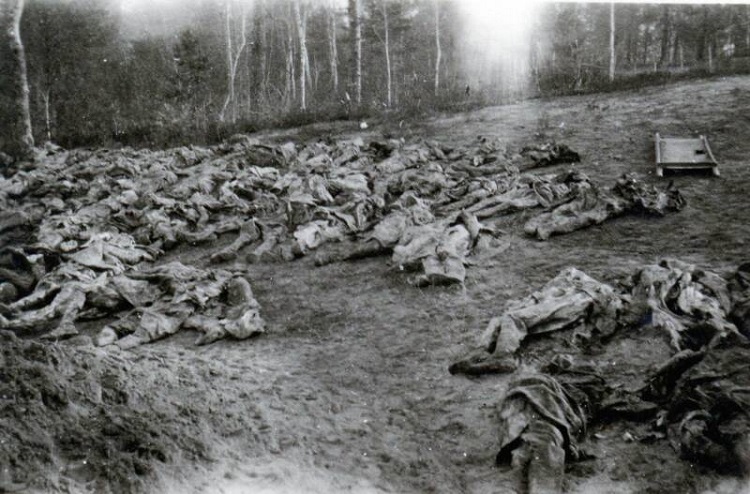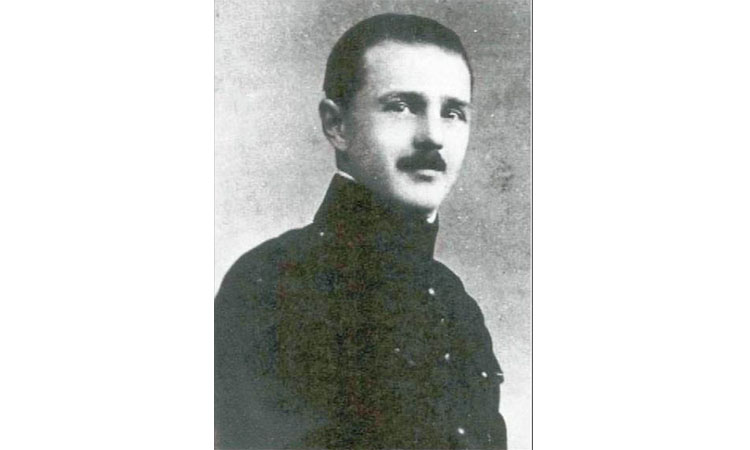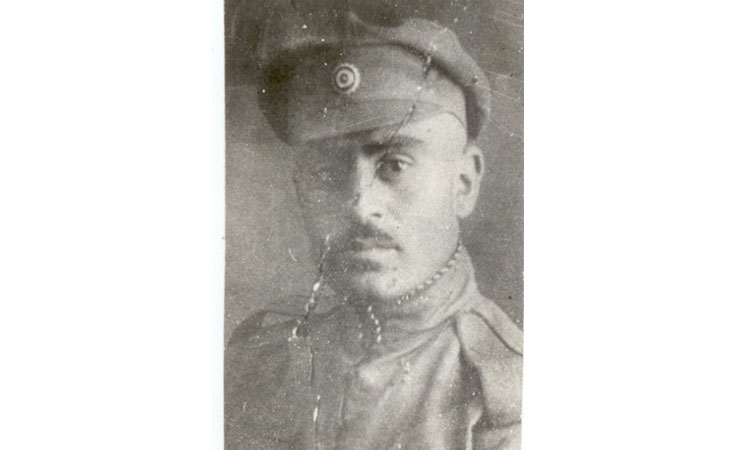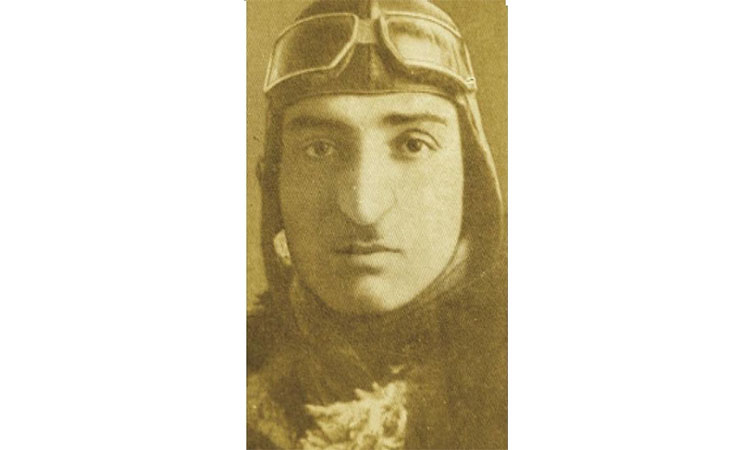Georgian victims of the Katyn massacre
The unsung Georgian heroes who fought for Poland

The story of Georgian officers in Poland was illustrated in this photo album owned by Giorgi Mamaladze, shot in Katyn. His widow found it by chance, the album was buried in the garden by her husband to avoid persecution by Soveit KGB. Photo:page from Mamaladze's album

These days world is marking the 79th anniversary since the Katyn Massacre: the mass shooting of more than 20,000 Polish officers and other prisoners of war in western Russia near Smolensk.
It is not widely known that Georgian officers were among the victims of the Soviet execution. Up to now, only five names of the Georgian victims of Katyn are known, but historic documents related to this tragedy are still the topic of research as hundreds of Georgians were accepted by Poland to serve in the Polish army between 1922 to 1924.
Agenda.ge asked former Georgian Ambassador to Poland, Konstantin Kavtaradze, to tell the incredible story of Georgians fighting for Poland’s freedom. He began researching the files of Georgian officers at the Polish archives in 2006 after an unexpected conversation with President of Poland Lech Kaczynski.
Unexpected Georgian memories of President Kaczynski
On April 10, I was invited as the Georgian Ambassador to Canada by Canada’s Polish diaspora to the church of St. Hyacinth in Ottawa for a remembrance service held to commemorate the 79th Anniversary of the Katyn Massacre and the 9th anniversary of the Smolensk plane crash that killed the Polish President Lech Kaczynski and all 96 passengers on board.
While listening to the eulogy delivered by the leader of the diaspora, Professor Jablonsky, I remembered my first meeting with President Kaczynski.
 The grave of the Katyn Forest Massacre was found in 1943.
The grave of the Katyn Forest Massacre was found in 1943.
In March 2006, as the newly appointed Georgian Ambassador to Poland, I presented my letters of credence to the Polish president. We were sitting in a reception room at the Presidential Palace, talking about bilateral relations, Georgia’s NATO and EU aspirations.
At the end of the meeting I told him a story about Georgian officers in the Polish army – Georgian soldiers who fought to defend their country against the Bolshevik Russian invasion of February 1921.
Following the occupation of Georgia by Russian forces, from 1922 to 1924, hundreds of Georgian Junkers and officers were accepted by Poland and enrolled in the Polish army as contract officers.
They took part in the 1939 Campaign, resisted the Soviet invasion of Poland, fought in the 1944 Warsaw uprising and several of them were killed in Katyn alongside Polish officers.

Major Giorgi Mamaladze is one of the Georgian victims of Katyn. His widow discovered the details of the story of Georgian officers in Poland after she found by chance husband's photo album buried in the garden to avoid persecution by Soviets. Photo: Mamaladze's family archive
For decades these officers were considered enemies of the Soviet regime and socialist Poland and subsequently efforts were made to erase their names from history. This was the reason why only a few people in Georgia and Poland knew about their existence.
So I expected questions from the president, but instead he started to name those officers, telling me the stories of their lives and service. He told me his father knew some of these Georgian officers – they had fought together in the Warsaw Uprising. He remembered how his father used to talk about those Georgians after the war.
We agreed that more efforts were needed to raise awareness about Georgian contract officers both among Poles and Georgians.
How were Georgian officers accepted into the Polish army?
With the help of our Polish friends, in 2006 the Georgian Embassy started searching for and studying the files of Georgian officers at the Rembertow Military Archive. Professor Wojciech Matersky, Colonel Tadeusz Krząstek, Professor David Kolbaia, film director Jerzy Lubach, the Director of the Warsaw Uprising Museum Jan Ołdakowski and his deputies Dariusz Gawin and Paweł Ukielski, all were part of this joint endeavour.
Amazing stories of the brave, loyal and highly-skilled Georgian officers emerged.
It was the summer of 1921, when the chairman of the Georgian Committee in Warsaw, Sergo Kurulishvili, addressed the Polish Minister of Military Affairs, General Kazimierz Sosnkowski, with a proposal to accept Georgians into Polish military schools.
On the decision of the Head of the Polish State, First Marshal Józef Piłsudski in December 1921, the first group of Georgian Junkers were admitted to the Cadet School in Warsaw.
The following year, an additional 22 Georgians were accepted. 18 Georgians then continued their education at the Officers School of Infantry, also located in Warsaw. In addition, 10 Georgians graduated from the Central School of Cavalry in Grudziądz. A few also graduated from the Officers Schools of Artillery and Engineering.
For the Georgian officers, the opportunity to consolidate their acquired knowledge through further active military service was a priority. Thus, the decision to admit Georgian officers to serve in the Polish Army was quickly taken by the Polish leadership.
In September 1922, eight high-ranking Georgian officers arrived in Warsaw: three generals, one colonel and four captains, who were sent to courses at the Army Training Center in Rembertów.
By 1939, 101 Georgians were serving in the Polish Army as contract officers
For their loyalty to Poland, as well as their very high qualifications, Georgian officers enjoyed high esteem and respect among their colleagues and superiors. At the same time, they actively participated in the life of the Georgian community in Poland - members of the Georgian Committee were General Zakhariadze and Colonels Bagrationi, Indjia and Kandelaki.

Officers of the Polish Army in 1938-1939, Georgians are among them. Photo from Giorgi Mamaladze's family archive
All contract officers retained their Georgian citizenship. In the event of the outbreak of war as foreigners they were not obliged to participate in it. However, all 101 contract officers declared their willingness to take part in military operations.
In September 1939, after the German attack, Colonel Roman Gvelesiani became the commander of the defense of Krakow. Captain Viktor Lomidze was the deputy commander of the minesweeper Gryf and after the captain was killed he took command of the ship. Major Dimitry Shalikashvili, the father of the US General John Shalikashvili, was a commanding officer of the elite Polish cavalry regiment and participated in the September campaign.
During the Polish-German war of 1939, the contract officers played a major role in defending Warsaw: Lieutenant Colonel Valerian Tevzadze was the commander of the northern section of defence. The chief of staff of the defense of Warsaw, Colonel Tadeusz Tomaszewski, wrote in his memoirs that Colonel Tevzadze “is a modest, gentle, good man and hard flint. Despite the extremely difficult conditions, he fulfilled the trust placed on him to the end. He was a model in every respect". For his bravery Tevzadze was decorated with the cross of Virtuti Militari.
Another contract officer who distinguished himself during the battle for Warsaw was Major Artemi Aronishidze, commander of the 2nd battalion of the 41st infantry division. Major Vladimer Siamashvili was in charge of one of the battalions responsible for the defence of the strategically important Praga district of Warsaw.
George (Jerzy) Tumanishvili, was enrolled in the Polish Naval Academy In 1935. During World War II, he served as an artillery officer on the Polish naval ships Burza, Ouragan, Krakowiak and Piorun. He participated in various combat missions, including the Norwegian Campaign, the Battle at Calais, the Atlantic Convoys, the actions in the Bay of Biscay, and the D-Day operations. In 1944, Tumanishvili was promoted to Captain of the Polish navy.

Leituenant Ilia Kakabadze was shot during the Katyn Massacre. Photo from Mamaladze's album
In 1939 Georgian officers also participated in battles against Soviet army units invading from the east. One of them, the officer of the 2nd Armored Battalion, Captain Ratishvili was killed by the Soviets on the battlefield.

The other Georgian victim of Katyn, fighter pilot Captain Arkadi Skhirtladze. Photo from Skhirtladze's family archive
Five of them – General Alexander Chkheidze, Major Giorgi Mamaladze, Captain Arkadi Skhirtladze, Captain Mikheil Rusiashvili and Leituenant Ilia Kakabadze were captured by the Soviet army and in 1940, together with almost 25,000 Polish officers, were executed in Katyn and surrounding areas.
Georgians in the 1944 Warsaw Uprising
Georgians also fought in the 1944 Warsaw Uprising. Daughter of the Captain Arkadi Skhirtladze, Irena Schirtładze, nicknamed Irka, became one of the symbols of the uprising.
At 16 years old she was a liaison officer of the Polish Home Army (Armia Krajowa) Parasol battalion. The Germans shot her on Ludna Street in Warsaw. Irka was posthumously awarded the Cross of Valor.
Georgian officers fighting side by side with Poles during the Warsaw uprising included Artemi Aronishidze, Mikheil Rusiashvili, Yuri Alkhazashvili, Vano and Giorgi Babulishvili, Yuri Babashvili, Elizbar Janjgava, Giorgi Kuchava, Ioseb Tamaradze, Vano Kavtaradze.
 Members of the Polish resistance platoon 'Agaton' pass through building rubble in downtown Warsaw during the 1944 uprising in the city. Photo: Warsaw Uprising Museum.
Members of the Polish resistance platoon 'Agaton' pass through building rubble in downtown Warsaw during the 1944 uprising in the city. Photo: Warsaw Uprising Museum.
After the Soviet takeover of Poland, Georgian officers who remained in the country fell victim to repression by the communist authorities.
Major Nikoloz Matikashvili was forced to retire from the army. Many of his colleagues were deported to Soviet labour camps. Lieutenant Colonel Valerian Tevzadze, the hero of the Warsaw’s defence, changed his name to Walery Krzyżanowski and for the rest of his life lived in a quiet, small town of Dzierżoniów in the west of Poland.
To preserve the memory of Georgian officers of the Polish Army, in 2006 a documentary was shot about their life and service. In April 2007, Presidents of Poland and Georgia opened a memorial dedicated to the Georgian officers in the Freedom Park of the Warsaw Uprising Museum; in 2011, in a small town of Piaseczno, near Warsaw, in the house of the Georgian officer Nikoloz Matikashvili, we inaugurated the Museum of Georgian Officers named after him.
Standing by Georgians during the war days of 2008 in Tbilisi
At midnight August 10, 2008, in the midst of Russian-Georgian war, I went to see President Kaczynski at the Presidential Palace.
It was late, we were sitting in the same room where I had presented my credentials two years ago. We talked about the Russian aggression, the grave situation on the ground and preparations for a Russian attack on Tbilisi. I remember that he took the phone and called the leaders of Estonia, Lithuania, Latvia and Ukraine, and offered them to fly together to Georgia.
 Lech Kaczynski (on the left) standing in front of the Georgian Parliament building addressing the crowd on 11 August 2008. Photo: president.pl
Lech Kaczynski (on the left) standing in front of the Georgian Parliament building addressing the crowd on 11 August 2008. Photo: president.pl
Next day we flew aboard the Polish President’s plane to Tbilisi via Ganja, Azerbaijan. On August 11, at the most crucial moment for my country, Lech Kaczynski was standing in front of the Georgian Parliament building addressing the crowd which gathered to welcome him and his colleagues.
I believe this was not just a courageous political move and show of solidarity. By standing with Georgia, by supporting its freedom, he also paid tribute to those Georgian officers of Polish Army who fought for the independence and freedom of Poland.
Every year, on August 1, the first day of the Warsaw Uprising, many Poles and local Georgians residing in the city visit the Uprising Museum. Many of them light candles in front of the Memorial to Georgian Officers in Freedom Park and pray for those who gave their lives for Georgia and Poland.
 Tweet
Tweet  Share
Share
